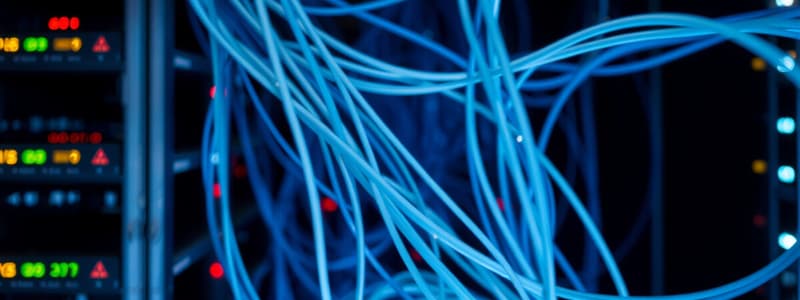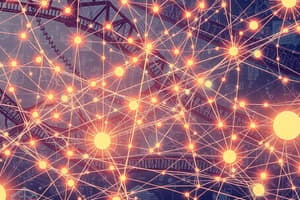Podcast
Questions and Answers
What is the Internet?
What is the Internet?
- Network of networks (correct)
- A single network
- A standalone computer
- A network protocol
Which of the following are examples of communication links?
Which of the following are examples of communication links?
- Fiber
- Copper
- Radio
- All of the above (correct)
Protocols control sending and receiving of messages in the Internet.
Protocols control sending and receiving of messages in the Internet.
True (A)
What does ISP stand for?
What does ISP stand for?
The transmission rate is referred to as _____
The transmission rate is referred to as _____
Give an example of a human protocol.
Give an example of a human protocol.
What is the role of protocols in network communication?
What is the role of protocols in network communication?
Match the following terms with their descriptions:
Match the following terms with their descriptions:
What is the Internet described as in a 'nuts and bolts' view?
What is the Internet described as in a 'nuts and bolts' view?
Which of the following are types of communication links mentioned?
Which of the following are types of communication links mentioned?
Protocols only govern communication among human entities.
Protocols only govern communication among human entities.
TCP, IP, and HTTP are examples of _____ protocols.
TCP, IP, and HTTP are examples of _____ protocols.
What does RFC stand for?
What does RFC stand for?
What does IETF stand for?
What does IETF stand for?
List one type of service the Internet provides.
List one type of service the Internet provides.
Match the following devices with their functions:
Match the following devices with their functions:
Packet switches are responsible for forwarding packets of data.
Packet switches are responsible for forwarding packets of data.
What is the primary function of a router?
What is the primary function of a router?
Flashcards are hidden until you start studying
Study Notes
Overview of Computer Networks and the Internet
- The Internet is a vast "network of networks," connecting billions of devices and enabling communication between them.
- Key components include hosts (end systems like PCs, laptops, smartphones), communication links (wired and wireless), and routing equipment (routers and switches).
Internet Protocols and Standards
- Protocols like TCP (Transmission Control Protocol), IP (Internet Protocol), and HTTP (Hypertext Transfer Protocol) manage the sending and receiving of messages.
- Internet standards are established through RFC (Request for Comments) documents, managed by the IETF (Internet Engineering Task Force).
Network Structure
- Network Edge: The point where users access the network; consists of end systems like desktops, smartphones, and servers.
- Network Core: Comprises high-capacity routers and switches that forward packets across the network.
Packet Switching vs. Circuit Switching
- Packet switching involves dividing messages into packets that are forwarded independently, optimizing bandwidth.
- Circuit switching establishes a dedicated path for the duration of a communication session, traditionally used in telephone networks.
Communication Links and Bandwidth
- Communication can occur over various media:
- Wireless (radio, satellite)
- Wired (fiber, copper)
- Bandwidth refers to the transmission rate of these links, influencing how much data can be sent simultaneously.
Fun Internet-Connected Devices
- Examples include smart home devices like Internet refrigerators, security cameras, smart beds, and even network-enabled gaming devices and health monitors (e.g., Fitbits).
Internet Services and Applications
- The Internet provides various services, including web browsing, video streaming, VoIP (Voice over Internet Protocol), email, gaming, and e-commerce.
- Programming interfaces facilitate application connections to the Internet, providing hooks for sending and receiving data.
Understanding Protocols
- Protocols define communication rules, including message formats, sequencing, and actions taken during message exchange.
- Human vs. Network Protocols:
- Example: Asking "What's the time?" correlates to machines sending structured messages and expecting defined responses.
Internet Engineering and Management
- The IETF plays a pivotal role in developing and maintaining Internet standards, ensuring interoperability and functionality across diverse systems and applications.
Overview of Computer Networks and the Internet
- The Internet is a vast "network of networks," connecting billions of devices and enabling communication between them.
- Key components include hosts (end systems like PCs, laptops, smartphones), communication links (wired and wireless), and routing equipment (routers and switches).
Internet Protocols and Standards
- Protocols like TCP (Transmission Control Protocol), IP (Internet Protocol), and HTTP (Hypertext Transfer Protocol) manage the sending and receiving of messages.
- Internet standards are established through RFC (Request for Comments) documents, managed by the IETF (Internet Engineering Task Force).
Network Structure
- Network Edge: The point where users access the network; consists of end systems like desktops, smartphones, and servers.
- Network Core: Comprises high-capacity routers and switches that forward packets across the network.
Packet Switching vs. Circuit Switching
- Packet switching involves dividing messages into packets that are forwarded independently, optimizing bandwidth.
- Circuit switching establishes a dedicated path for the duration of a communication session, traditionally used in telephone networks.
Communication Links and Bandwidth
- Communication can occur over various media:
- Wireless (radio, satellite)
- Wired (fiber, copper)
- Bandwidth refers to the transmission rate of these links, influencing how much data can be sent simultaneously.
Fun Internet-Connected Devices
- Examples include smart home devices like Internet refrigerators, security cameras, smart beds, and even network-enabled gaming devices and health monitors (e.g., Fitbits).
Internet Services and Applications
- The Internet provides various services, including web browsing, video streaming, VoIP (Voice over Internet Protocol), email, gaming, and e-commerce.
- Programming interfaces facilitate application connections to the Internet, providing hooks for sending and receiving data.
Understanding Protocols
- Protocols define communication rules, including message formats, sequencing, and actions taken during message exchange.
- Human vs. Network Protocols:
- Example: Asking "What's the time?" correlates to machines sending structured messages and expecting defined responses.
Internet Engineering and Management
- The IETF plays a pivotal role in developing and maintaining Internet standards, ensuring interoperability and functionality across diverse systems and applications.
Studying That Suits You
Use AI to generate personalized quizzes and flashcards to suit your learning preferences.




